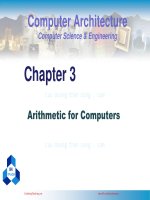kiến trúc máy tính phạm minh cường chương ter4 part3 the processorsinhvienzone com
Bạn đang xem bản rút gọn của tài liệu. Xem và tải ngay bản đầy đủ của tài liệu tại đây (860.65 KB, 23 trang )
Computer Architecture
Chapter 4: The Processor Part 3
Dr. Phạm Quốc Cường
Adapted from Computer Organization the Hardware/Software Interface – 5th
Computer Engineering – CSE – HCMUT
CuuDuongThanCong.com
/>
1
Instruction-Level Parallelism (ILP)
• Pipelining: executing multiple instructions in parallel
• To increase ILP
– Deeper pipeline
• Less work per stage shorter clock cycle
– Multiple issue
•
•
•
•
Replicate pipeline stages multiple pipelines
Start multiple instructions per clock cycle
CPI < 1, so use Instructions Per Cycle (IPC)
E.g., 4GHz 4-way multiple-issue
– 16 BIPS, peak CPI = 0.25, peak IPC = 4
• But dependencies reduce this in practice
Chapter 4 — The Processor — 2
CuuDuongThanCong.com
/>
Multiple Issue
• Static multiple issue
– Compiler groups instructions to be issued together
– Packages them into “issue slots”
– Compiler detects and avoids hazards
• Dynamic multiple issue
– CPU examines instruction stream and chooses instructions
to issue each cycle
– Compiler can help by reordering instructions
– CPU resolves hazards using advanced techniques at
runtime
Chapter 4 — The Processor — 3
CuuDuongThanCong.com
/>
Speculation
• “Guess” what to do with an instruction
– Start operation as soon as possible
– Check whether guess was right
• If so, complete the operation
• If not, roll-back and do the right thing
• Common to static and dynamic multiple issue
• Examples
– Speculate on branch outcome
• Roll back if path taken is different
– Speculate on load
• Roll back if location is updated
Chapter 4 — The Processor — 4
CuuDuongThanCong.com
/>
Compiler/Hardware Speculation
• Compiler can reorder instructions
– e.g., move load before branch
– Can include “fix-up” instructions to recover from
incorrect guess
• Hardware can look ahead for instructions to
execute
– Buffer results until it determines they are actually
needed
– Flush buffers on incorrect speculation
Chapter 4 — The Processor — 5
CuuDuongThanCong.com
/>
Speculation and Exceptions
• What if exception occurs on a speculatively
executed instruction?
– e.g., speculative load before null-pointer check
• Static speculation
– Can add ISA support for deferring exceptions
• Dynamic speculation
– Can buffer exceptions until instruction completion
(which may not occur)
Chapter 4 — The Processor — 6
CuuDuongThanCong.com
/>
Static Multiple Issue
• Compiler groups instructions into “issue
packets”
– Group of instructions that can be issued on a
single cycle
– Determined by pipeline resources required
• Think of an issue packet as a very long
instruction
– Specifies multiple concurrent operations
– Very Long Instruction Word (VLIW)
Chapter 4 — The Processor — 7
CuuDuongThanCong.com
/>
Scheduling Static Multiple Issue
• Compiler must remove some/all hazards
– Reorder instructions into issue packets
– No dependencies with a packet
– Possibly some dependencies between packets
• Varies between ISAs; compiler must know!
– Pad with nop if necessary
Chapter 4 — The Processor — 8
CuuDuongThanCong.com
/>
MIPS with Static Dual Issue
• Two-issue packets
– One ALU/branch instruction
– One load/store instruction
– 64-bit aligned
• ALU/branch, then load/store
• Pad an unused instruction with nop
Address
Instruction type
Pipeline Stages
n
ALU/branch
IF
ID
EX
MEM
WB
n+4
Load/store
IF
ID
EX
MEM
WB
n+8
ALU/branch
IF
ID
EX
MEM
WB
n + 12
Load/store
IF
ID
EX
MEM
WB
n + 16
ALU/branch
IF
ID
EX
MEM
WB
n + 20
Load/store
IF
ID
EX
MEM
WB
Chapter 4 — The Processor — 9
CuuDuongThanCong.com
/>
MIPS with Static Dual Issue
Chapter 4 — The Processor — 10
CuuDuongThanCong.com
/>
Hazards in the Dual-Issue MIPS
• More instructions executing in parallel
• EX data hazard
– Forwarding avoided stalls with single-issue
– Now can’t use ALU result in load/store in same packet
• add $t0, $s0, $s1
load $s2, 0($t0)
• Split into two packets, effectively a stall
• Load-use hazard
– Still one cycle use latency, but now two instructions
• More aggressive scheduling required
Chapter 4 — The Processor — 11
CuuDuongThanCong.com
/>
Scheduling Example
• Schedule this for dual-issue MIPS
Loop: lw
addu
sw
addi
bne
Loop:
$t0,
$t0,
$t0,
$s1,
$s1,
0($s1)
$t0, $s2
0($s1)
$s1,–4
$zero, Loop
#
#
#
#
#
$t0=array element
add scalar in $s2
store result
decrement pointer
branch $s1!=0
ALU/branch
Load/store
cycle
nop
lw
1
addi $s1, $s1,–4
nop
2
addu $t0, $t0, $s2
nop
3
bne
sw
$s1, $zero, Loop
$t0, 0($s1)
$t0, 4($s1)
IPC = 5/4 = 1.25 (c.f. peak IPC = 2)
Chapter 4 — The Processor — 12
CuuDuongThanCong.com
/>
4
Loop Unrolling
• Replicate loop body to expose more
parallelism
– Reduces loop-control overhead
• Use different registers per replication
– Called “register renaming”
– Avoid loop-carried “anti-dependencies”
• Store followed by a load of the same register
• Aka “name dependence”
– Reuse of a register name
Chapter 4 — The Processor — 13
CuuDuongThanCong.com
/>
Loop Unrolling Example
• IPC = 14/8 = 1.75
– Closer to 2, but at cost of registers and code size
Loop:
ALU/branch
Load/store
cycle
addi $s1, $s1,–16
lw
$t0, 0($s1)
1
nop
lw
$t1, 12($s1)
2
addu $t0, $t0, $s2
lw
$t2, 8($s1)
3
addu $t1, $t1, $s2
lw
$t3, 4($s1)
4
addu $t2, $t2, $s2
sw
$t0, 16($s1)
5
addu $t3, $t4, $s2
sw
$t1, 12($s1)
6
nop
sw
$t2, 8($s1)
7
sw
$t3, 4($s1)
8
bne
$s1, $zero, Loop
Chapter 4 — The Processor — 14
CuuDuongThanCong.com
/>
Dynamic Multiple Issue
• “Superscalar” processors
• CPU decides whether to issue 0, 1, 2, … each
cycle
– Avoiding structural and data hazards
• Avoids the need for compiler scheduling
– Though it may still help
– Code semantics ensured by the CPU
Chapter 4 — The Processor — 15
CuuDuongThanCong.com
/>
Dynamic Pipeline Scheduling
• Allow the CPU to execute instructions out of
order to avoid stalls
– But commit result to registers in order
• Example
lw
$t0, 20($s2)
addu $t1, $t0, $t2
sub
$s4, $s4, $t3
slti $t5, $s4, 20
– Can start sub while addu is waiting for lw
Chapter 4 — The Processor — 16
CuuDuongThanCong.com
/>
Dynamically Scheduled CPU
Preserves
dependencies
Hold pending
operands
Results also sent
to any waiting
reservation stations
Reorders buffer for
register writes
CuuDuongThanCong.com
Can supply
operands for
issued instructions
Chapter 4 — The Processor — 17
/>
Register Renaming
• Reservation stations and reorder buffer
effectively provide register renaming
• On instruction issue to reservation station
– If operand is available in register file or reorder
buffer
• Copied to reservation station
• No longer required in the register; can be overwritten
– If operand is not yet available
• It will be provided to the reservation station by a
function unit
• Register update may not be required
Chapter 4 — The Processor — 18
CuuDuongThanCong.com
/>
Speculation
• Predict branch and continue issuing
– Don’t commit until branch outcome determined
• Load speculation
– Avoid load and cache miss delay
•
•
•
•
Predict the effective address
Predict loaded value
Load before completing outstanding stores
Bypass stored values to load unit
– Don’t commit load until speculation cleared
Chapter 4 — The Processor — 19
CuuDuongThanCong.com
/>
Why Do Dynamic Scheduling?
• Why not just let the compiler schedule code?
• Not all stalls are predicable
– e.g., cache misses
• Can’t always schedule around branches
– Branch outcome is dynamically determined
• Different implementations of an ISA have
different latencies and hazards
Chapter 4 — The Processor — 20
CuuDuongThanCong.com
/>
Does Multiple Issue Work?
The BIG Picture
• Yes, but not as much as we’d like
• Programs have real dependencies that limit ILP
• Some dependencies are hard to eliminate
– e.g., pointer aliasing
• Some parallelism is hard to expose
– Limited window size during instruction issue
• Memory delays and limited bandwidth
– Hard to keep pipelines full
• Speculation can help if done well
Chapter 4 — The Processor — 21
CuuDuongThanCong.com
/>
Power Efficiency
• Complexity of dynamic scheduling and
speculations requires power
• Multiple simpler cores may be better
Microprocessor
Year
Clock Rate
Pipeline
Stages
Issue
width
Out-of-order/
Speculation
Cores
Power
i486
1989
25MHz
5
1
No
1
5W
Pentium
1993
66MHz
5
2
No
1
10W
Pentium Pro
1997
200MHz
10
3
Yes
1
29W
P4 Willamette
2001
2000MHz
22
3
Yes
1
75W
P4 Prescott
2004
3600MHz
31
3
Yes
1
103W
Core
2006
2930MHz
14
4
Yes
2
75W
UltraSparc III
2003
1950MHz
14
4
No
1
90W
UltraSparc T1
2005
1200MHz
6
1
No
8
70W
Chapter 4 — The Processor — 22
CuuDuongThanCong.com
/>
Concluding Remarks
• ISA influences design of datapath and control
• Datapath and control influence design of ISA
• Pipelining improves instruction throughput
using parallelism
– More instructions completed per second
– Latency for each instruction not reduced
• Hazards: structural, data, control
• Multiple issue and dynamic scheduling (ILP)
– Dependencies limit achievable parallelism
– Complexity leads to the power wall
Chapter 4 — The Processor — 23
CuuDuongThanCong.com
/>









